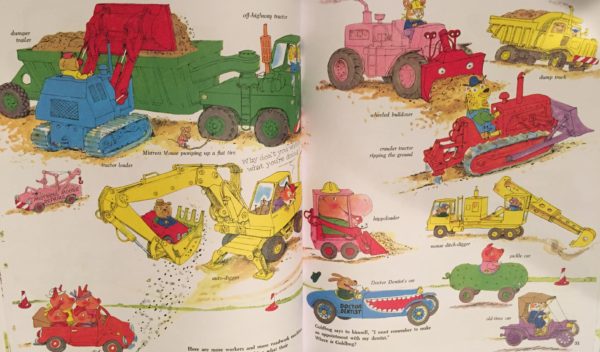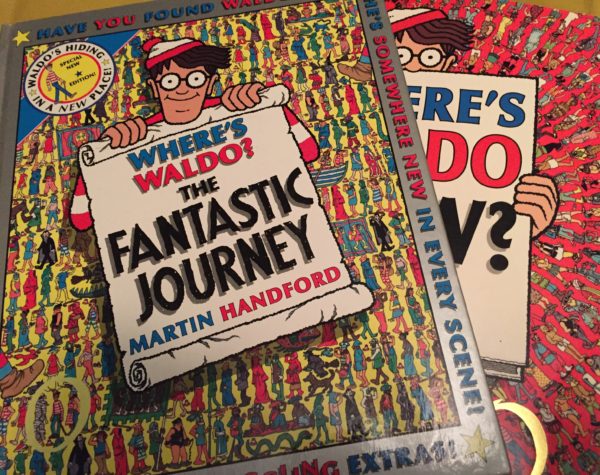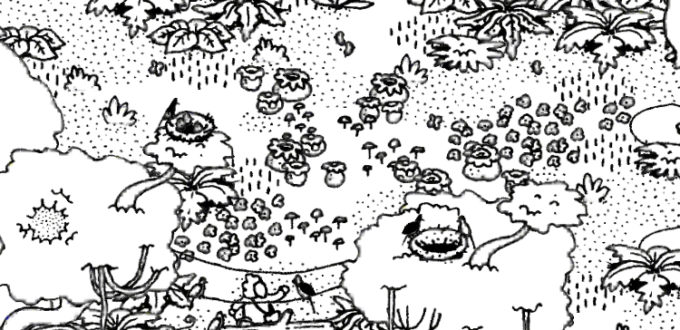Doodling Vignettes
I miss my family’s dot matrix printer. Not for its agonizingly slow speed, nor for the shrieking, scraping sounds it made while again, printing any document with a glacial pace that drove you to madness.
It was the paper. A series of perforated sheets connected into an endless, perfect medium for birthday banners and other intended outputs. For me though, after tearing off its flanking punched strips I could doodle an action packed landscape of war machines, silly stick figure shenanigans, or haunted Halloween scenes of comedic horror without fear of hitting a margin. I loved packing vignettes into these landscapes, each little piece, person, or creature telling their own little story.
Now with a kid of my own, reading the Richard Scarry books I adored as a child, I’ve perhaps discovered the genesis of my childhood fascination with panoramas of chaos.

Mr. Scarry was a master of busy scenes, and relevant to the inspiration of this post, he later included in his books little Easter eggs for sleuths like myself to find.

The budding beginnings of an interest in this form of storytelling were enhanced by the liberal use of a library card. While my youngest brother is the artist of the family I can doodle with the best of them, my skills honed after checking out Ed Emberly‘s drawing books from the library ten thousand times. To this day I can draw his masterfully silly skeletons without a second thought.

Thereafter it was Halloween year round for me. I doodled endlessly and once a teacher commented on the scene I had drawn in the margins of a worksheet, “I’m not sure what’s going on here but it’s funny. Please pay attention in class.”
Naturally I was later drawn to the phenomenon of the Where’s Waldo series, also checking those books out from the library ten thousand and one times. (Later as an adult I tracked them down and bought as many I could without drawing too many reproachful stares from my wife.)

The Where’s Waldo series were masterpieces of the form I loved. A million little scenes packed into a two page spread. Each little nook a reaction to the greater theme, with sight gags aplenty. The very mechanic of searching for Waldo, his friends, and his assorted lost items required that you soak up every inch of the page to complete the checklist.

Now, years later, a simple tweet of a trailer for the game Hidden Folks immediately grabbed my attention. A Where’s Waldo-inspired game with cute little drawn people and sound effects? Moreso, it’s doing what a book can’t, which is allowing for the picture hunt to be interactive by virtue of being digital?
I was sold. I even put Hidden Folks’ release date on my calendar. I was serious. The date arrived and I was surprised to discover that Hidden Folks would also be released as an app for phones. I waffled as surely the experience would be better on a big computer monitor, but I also wasn’t going to fool myself. My available free time for games on a real computer is slim at best these days. iPhone download initiated.

Hidden Folks turned out to be as advertised and yet offered a slightly different experience than I was expecting. It does the Where’s Waldo thing very well where you search for specific people and objects in different biomes. The cute world is voiced by grunts, squeaks, and squeals of the developers themselves. Tapping on objects often causes them to react in simple ways and it’s occasionally necessary to move things around to find an object from the list. The game has some smart, useful interface features like offering a hint for each thing to find so you’re not solely stumbling about, trying to find some microscopic object.

Strangely I’ve found Hidden Folks to be far more peaceful and contemplative than I would have imagined it to be. Its world only makes serene movements with gently waving and hopping people and creatures. It occasionally plays with the form, like its desert level where instead of hiding objects in chaos, it hides them in empty expanse. The goofy sounds everything makes when touched are fairly muted considering that the effects are all human voiced and could have easily crossed into being annoying. It’s been a nice game for my commute or for just before bedtime.

Disappointingly Hidden Folks, the actual game, doesn’t quite take me on a whirlwind nostalgia tour that just seeing its trailer did. The little people that populate its world are fairly uniform in appearance and rarely complement the theme that each level is going for. Most of them just kinda do this jumping jack animation and not much else. I get it though. Trying to give every little person custom animations would be a nightmare scenario for developing something of this detail and scale. It’s meant then that Hidden Folks hasn’t quite captured my imagination like I thought it would. It’s cute and I still enjoy the hunt for hidden objects which is what the game is really about, but that extra thing, that thing that felt like the game was made specially for me wasn’t actually there.
Nevertheless, Hidden Folks is very fine work and I’ve likely unfairly projected a lot onto it. It gave me the chance at meandering through this stream of consciousness, nostalgia-driven post. My son got a new Richard Scarry book as a result of me writing this so that’s a bonus in his world. Too bad my life is so digitally oriented now as I don’t have as many opportunities to doodle on real paper. I think during my next conference call at work I may have to work on my skeletons. I’m getting a little rusty.


